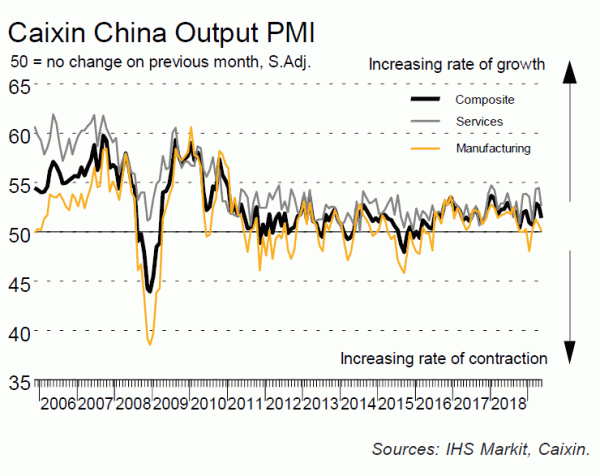China Caixin PMI Services dropped to 52.7 in May, down from 54.5 and missed expectation of 54.2. PMI Composite dropped to 5.15, down from 52.7. Markit noted that “overall confidence towards the year ahead weakened to the lowest on record, which was primarily driven by weaker sentiment at manufacturers”. Also, “expectations at goods producers were the least upbeat since the series began in April 2012″, ” services firms registered the lowest degree of confidence since July 2018″.
And, “subdued expectations were often linked to the ongoing China-US trade dispute and relatively subdued global demand conditions.”
Commenting on the China General Services PMI™ data, Dr. Zhengsheng Zhong, Director of Macroeconomic Analysis at CEBM Group said:
“The Caixin China General Services Business Activity Index fell to 52.7 in May from the recent high of 54.5 in April, although it remained firmly within expansionary territory. Among the gauges included in the survey:
- The gauge for new business fell from the past month’s recent high but remained in expansionary territory, reflecting slowing growth in demand across the services sector.
- The measure for employment fell from the past month’s recent high while remaining within expansionary territory, suggesting jobs growth is slowing.
- Gauges for input costs and prices charged by services providers both fell slightly while remaining in expansionary territory. Growth in input costs outpaced that of prices charged, indicating that services companies remained under significant pressure.
- The measure for business expectations continued to fall, despite staying in positive territory, reflecting services providers’ weakening confidence in their future prospects.
“The Caixin China Composite Output Index fell to 51.5 in May from 52.7 the month before, mainly due to slower growth in the service sector.
- The gauge for new orders edged down while remaining in expansionary territory, while the measure for new export orders returned to growth, pointing to weakening demand at home but improved demand abroad. The negative effects of China-U.S. tensions on exports have yet to emerge, perhaps due to exporters front-loading shipments of products that are in the remaining $300 billion of goods not subject to punitive tariffs.
- The employment gauge continued to fall, entering contractionary territory. This suggested the labor market is under pressure. In a move that is likely related, the State Council recently set up a new leading group on employment.
- Both gauges for input costs and output charges edged down while remaining in expansionary territory. Growth in input costs outpaced that of output charges, indicating companies continued to be squeezed.
- The measure for future output fell markedly, to the lowest reading since the series began in 2012, although it remained in positive territory. This indicates business confidence is in urgent need of a boost.
“Overall, China’s economic growth showed some signs of slowing in May. Employment and business confidence in particular merit policymakers’ attention.”
















